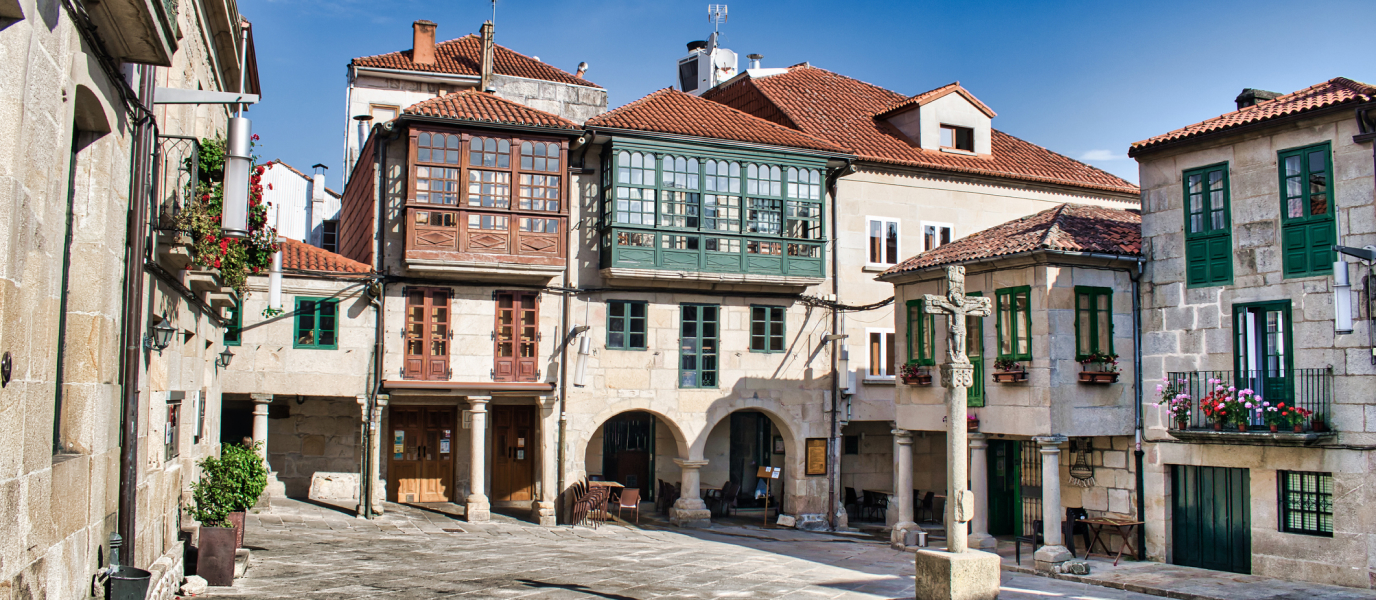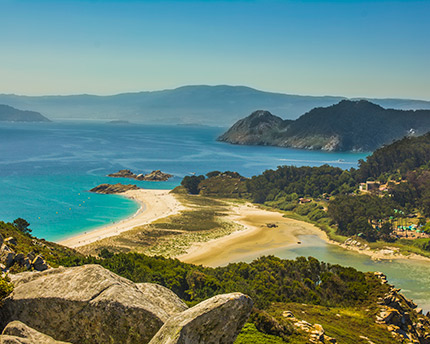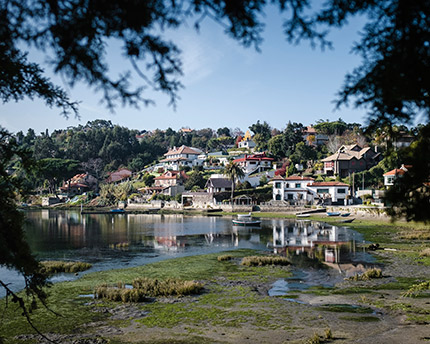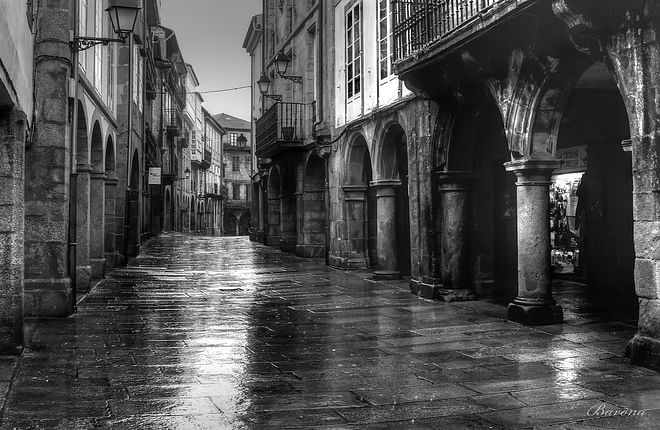Few know that Pontevedra has an incredible old town – the second best-conserved in Galicia after Santiago de Compostela. Nor do many know that its cobbled squares are home to the only shell-shaped church in the Iberian Peninsula and one of the earliest relief sculptures of a saint wearing glasses.
There are even legends about how Pontevedra was founded. In Renaissance times it was said that Teucer, a hero of the Trojan War, founded this city on the other side of the known world. What no one can agree on is just how Teucer reached the Lérez River, and one story even tells that he was guided here by a mermaid.
What to see in Pontevedra
Ruins of San Domingos
The ruins of this old convent stand elegantly in the centre of Pontevedra. It was built in the 13th century by the Dominicans and later destroyed during battles with the English. Attempts were made to rebuild a new church in the 18th century but the convent was ultimately sold and the project was never finished.
Today, the sections of the convent that still stand include the front, with five apses, and a side wall with a portico and rose window. The ruins have an almost mystic presence in the city and are a reminder of a past shaped by faith and war.
The ruins are part of the Provincial Museum of Pontevedra and for many years were used to exhibit tombs and pieces from the Roman era. However, these days the most valuable of these archaeological pieces have been removed to prevent damage by the weather.
The ruins can be visited from Easter Week until October and several treasures can still be viewed amid the remains of its chapels and windows.
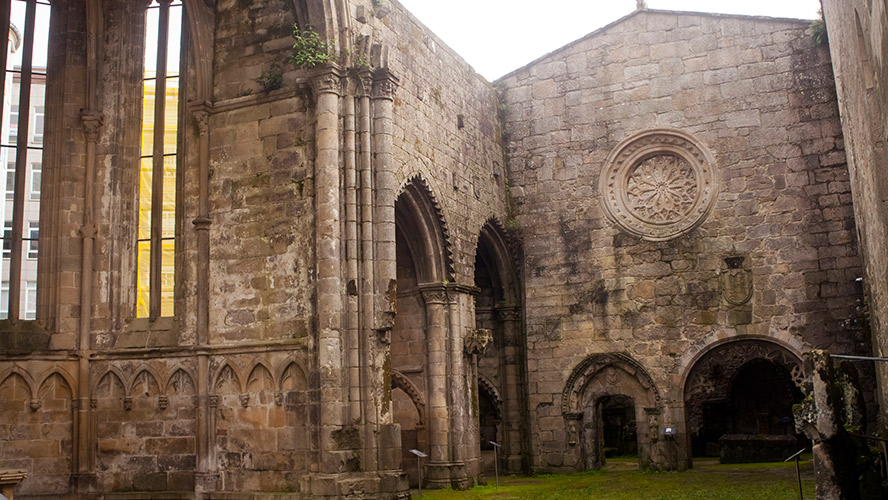
Praza da Peregrina
This square is now the heart of Pontevedra but it was originally built outside the walls that surrounded the city in the 18th century. It sat next to one of the gates into the city along the Portuguese Way of St James, meaning pilgrims following this route to Santiago de Compostela would always pass through it.
The church of the Virxe Peregrina, the only circular church in Spain, is the most eye-catching attraction of this lively cobbled square. In fact, it’s actually scallop-shaped rather than circular – the scallop is the symbol of pilgrims – and ends in a cross. The convex façade and atrium are the two most important features of the church, which is a constant reminder of the importance of pilgrims and the Way of St James to Pontevedra.
There used to be a fountain in front of the steps, which have been remodelled several times, but it was removed for many years and has now been rebuilt in its original form.
Another popular sight in the square is the statue of Ravachol the Parrot, a pet belonging to the celebrated pharmacist Perfecto Feijóo. The parrot was famous throughout the city and lived in a cage in the square at the beginning of the 20th century. Today all that remains is his statue, as sadly even the pharmacy has vanished.
Convent of San Francisco
According to legend, this giant 14th century convent and church was built on the wishes of Saint Francis of Assisi, who would have passed through Pontevedra on the Portuguese Way of St James.
The complex was built outside the city walls between 1310 and 1360 thanks to generous donations from the family of Pai Gomes Chariño, an admiral and troubadour from Pontevedra who belonged to one of the wealthiest noble houses in the area.
The temple has a Late Gothic interior and the rooms of the convent were the envy of other religious orders who looked on as its coffers overflowed with donations from rich families who feared the great illness of those times: the plague.
The tomb of Pai Gomes Chariño is inside the church, next to the high altar, alongside the tomb of two unknown married couples from the period.
The sculpture of the Nazarene is far more modern but equally venerated and it attracts many religious visitors to the church.
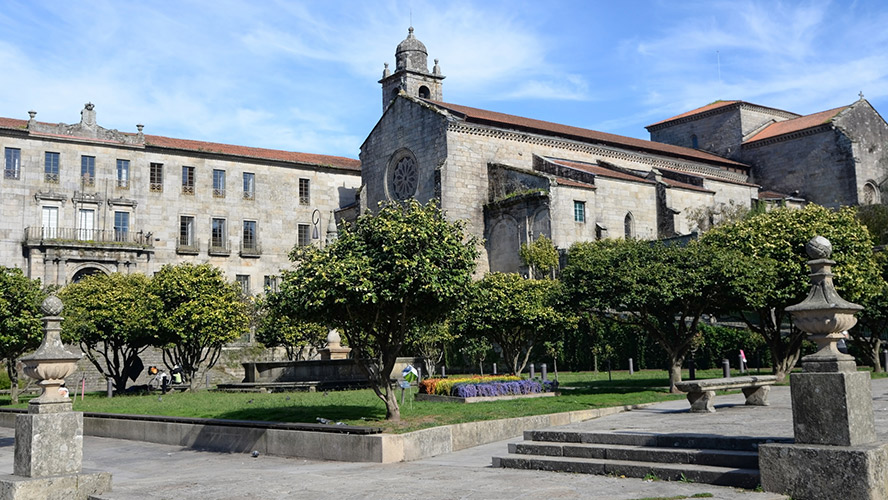
Basilica of Santa María la Mayor
This church was consecrated as a basilica by Pope John Paul II in 1962 and is the most important religious monument in Pontevedra. It was built in the 15th century, funded by donations from the Fishermen’s Guild who used it as their place of worship for centuries.
The site where today you can see this impressive “pearl of Galician art”, as it is known, once contained an older church that was pulled down to build the basilica. Its main façade was intended to look like a giant altarpiece with stone steps that perfectly exemplify local Renaissance architecture.
There are numerous legends linked to innovative features of the basilica, such as the portrayal of Saint Jerome wearing glasses, one of the earliest representations of its kind in art; and a relief sculpture of Pontevedra, the oldest to be conserved in the city, which gives you an idea of what it was like at this time.
Another intriguing relief sculpture can be found inside the façade where satires of the capital sins are combined with depictions of scenes from the lives of the saints.
While you’re inside the basilica, make sure to admire the rib vaulting, the stained-glass windows, the 16th century altar paintings, Christ of the Sailors (18th century) and Christ Taken Down from the Cross (16th century).
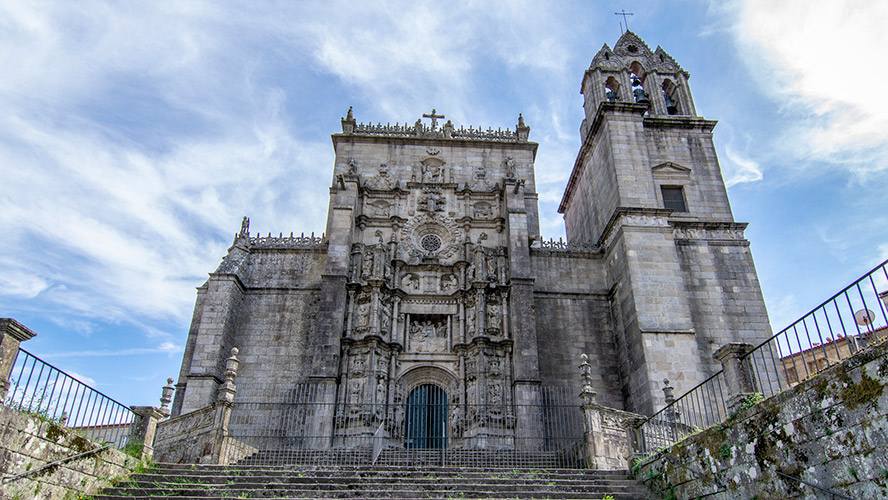
Praza da Verdura
These days Vigo might be Spain’s top city for Christmas lights, but not many know that Pontevedra was the second city in Spain to have public street lighting (March 1888), all thanks to the power station that stood in this square.
Today, you can still see the industrial chimney of the power plant and its former building now houses the tourist information office. The square is bustling with life throughout the day and night and is an essential stop on a visit to the city.
A daily fruit and vegetable market has been held in cobbled Praza da Verdura since the 15th century, hence the square’s name [verdura means vegetable]. Bars and restaurants sit under the surrounding buildings, some of which are over 500 years old, and it’s a great spot for a glass of wine, tapas, lunch or dinner any day of the week.
Praza da Leña
You can’t leave Pontevedra without visiting Praza da Leña and taking some incredible photos of the square. It’s one of the most visited places in the old town, constantly buzzing with life throughout the day thanks to the numerous surrounding terraces.
This regular-shaped space is name Praza da Leña because firewood used to be sold here when it was typically used in kitchens [leña means firewood].
Its sense of harmony comes from the cross in the centre and the beautiful houses around it, urban palaces that give you an idea of what traditional 18th century houses were like in Pontevedra. Take your time to admire the colonnade and stone balconies; one of the buildings here is part of the Provincial Museum.
The area around the square has some of the best places in the city for food and drink.
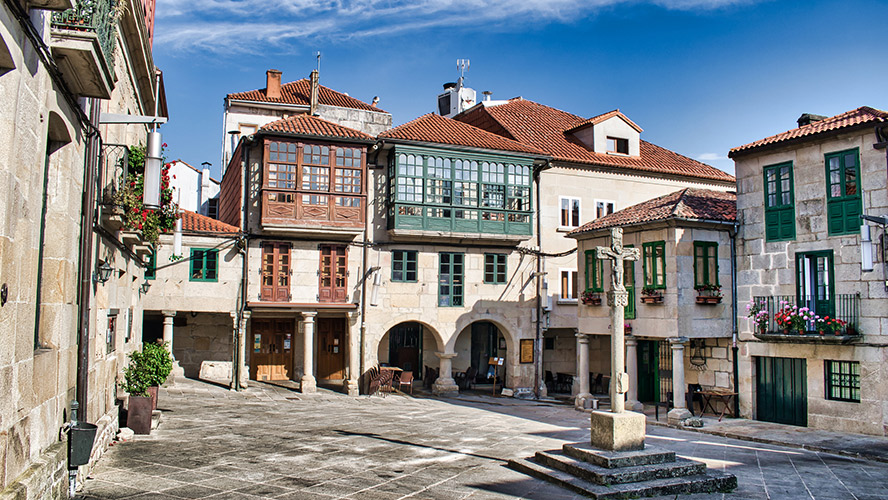
Pontevedra Museum
The residents of Pontevedra have good reason to be extremely proud of this museum, which is spread between six buildings across the city, because it’s considered to be one of the most important in Spain of its kind and contains one of the most valuable archives and libraries in Galicia.
The museum’s six buildings take you on a journey through Galician archaeology and art, and they are: Castro Monteagudo, García Flórez, Fernández López, Sarmiento, the ruins of the convent of San Domingos and a sixth, modern building between Rúa Serra and Rúa Padre Amoedo.
The first building, Castro Monteagudo in Praza da Leña, contains archaeology collections including gems from pre-Roman times, and masterpieces of locally made gold and silverwork.
The García Flórez building contains a display of jet pieces, engravings, religious sculptures and even a reproduction of part of the frigate Numancia, built in the 19th century to try and restore Spanish naval pride after the Battle of Trafalgar.
Other key buildings belonging to the museum are the ruins of the convent of San Domingos, which contains an incredible collection of heraldry and medieval tombs of important knights, and the final building, constructed so the museum can host temporary exhibitions.
Praza da Pedreira
This square is another part of Pontevedra that exudes dignity and harmony, particularly due to the Palace of Mugartegui.
The area is famous for the work of stone-carvers and their skill can be admired in the stone façades of many of the buildings here, which once belonged to the nobility.
The Palace of Mugartegui is an excellent example of Baroque architecture and was built between the 17th and18th centuries. It has an incredible portico with seven arches supported by columns and pilasters.
The main doorway is decorated with the stone coat of arms of the Figueroa, Araújo, Miranda and Quirós families, and a stone sundial that sits above the entrance arch.
Today the building is home to the Regulatory Board for Rías Baixas Designation of Origin Wine and, interestingly, it’s the most popular place for civil weddings held in the Pontevedra area.
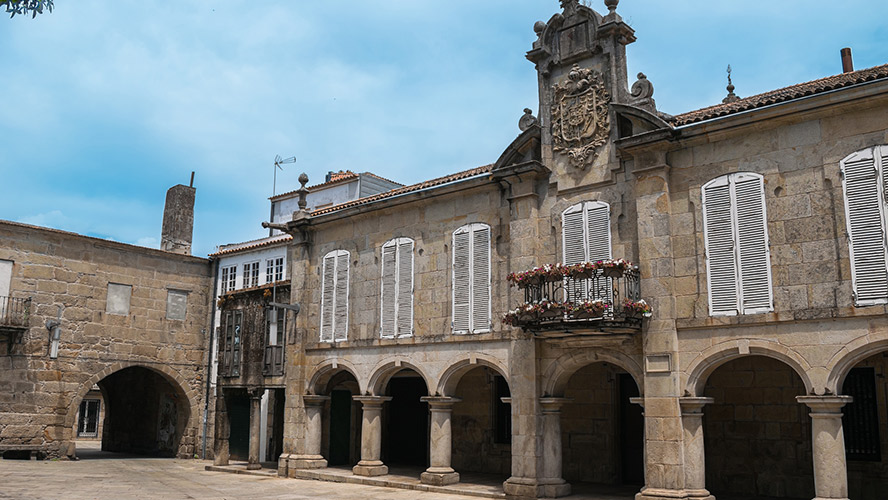
Stone Cross of Praza das Cinco Rúas
This stone cross was built in 1773 and is an exceptional example of popular art from this period; it stands in a square in the old town where five streets meet, hence the name [cinco rúas means five roads].
The cross is very close to the former house of Ramón María del Valle-Inclán, so this famous Galician writer would have certainly seen the figures on the base of the column. In fact, another writer, Castelao, made it famous in one of his works.
The first feature of the cross you’ll notice is Adam and Eve, portrayed right at the moment when Adam picks the forbidden fruit from the tree, with the snake entwined from the base of the cross to the front. But a far more disturbing image can be seen on another side, where two souls are consumed by flames, an image that is accompanied by an inscription or prayer for souls in purgatory.
St Anthony of Padua is at the top of the column holding baby Jesus in his arms.
What to see nearby
Atlantic Islands of Galicia National Park
This national park includes the most beautiful islands off this part of the Galician coast: the Cíes Islands, Ons, Sálvora and Cortegada. And, according to sources in the international media, this protected zone is even home to the most beautiful beach in the world: Rodas Beach.
The area’s fine sand and crystal-clear waters have been kept that way due to, among other reasons, the introduction of increasingly tight restrictions. The Cíes Islands, for example, are only open to the public in the summer with limited visitor numbers.
It’s well worth taking a few days to visit the islands at your own pace; once the refuge of pirates and maritime rebels, today you can enjoy hearing the sounds of seagulls from the lighthouse on the Cíes Islands. Or you can explore the mysterious furnas of Ons, sea caves that were once said to lead to hell itself, or recall the tragedy of the Santa Isabel, a boat that sank off the shores of the island in 1921, with all aboard losing their lives.
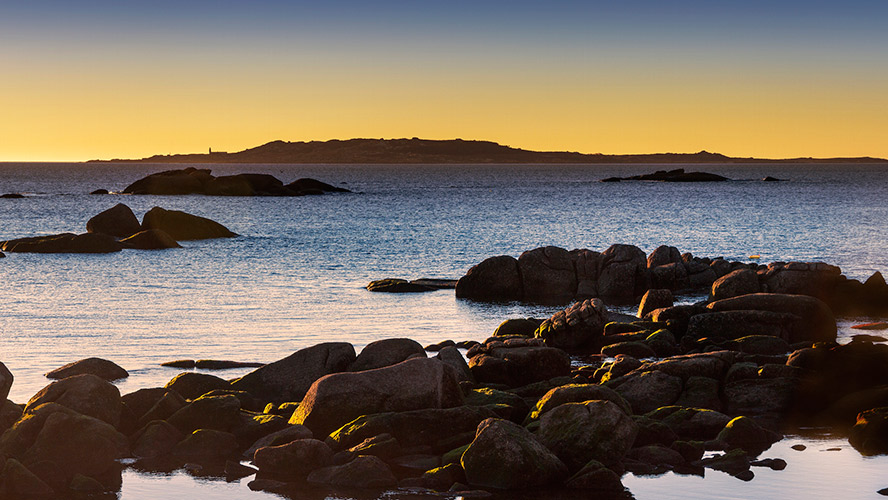
O Grove Peninsula
Known as the Galician Caribbean, the peninsula enjoys something highly valued in Galicia: a warmer, less rainy climate. Beaches here, such as Lanzada, give you a unique opportunity to enjoy fine, white sand and the cold water of the Atlantic, but there are other great beaches for swimming too. Other fun activities include climbing Mount Siradella and enjoying the magnificent views, going for a hike along the Piedras Negras trail, and even going on a boat trip to A Toxa Island.
And if you want the perfect end to your day, choose one of the many great restaurants here where you can enjoy some of the best seafood in the area.
Combarro
Combarrio is known as the town of the hórreos (typical granaries) and is one of the most enchanting in Galicia, often featuring on lists of the most beautiful towns in Spain. This is partly due to the numerous hórreos that still stand by the sea, giving the town an idyllic appearance at high tide. There are also nine stone crosses marking crossroads with images of the Virgin Mary that gaze out to sea, protecting the town’s sailors.
Take your time to explore its squares, cobbled streets and the sea front bars that are tucked away next to the hórreos where you can enjoy fantastic, inexpensive seafood.
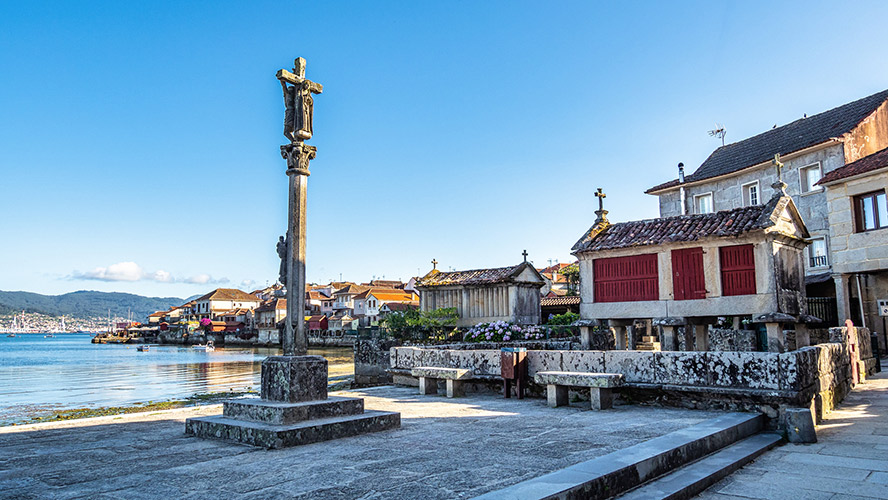
Palace of Lourizán
This history of this noble building can be traced back to the 15th century when a farm was built here, although only the dovecote belonging to the original farm remains. What you’ll see today at San André de Lourizán is the sometime residence and summer house of Buenaventura Marcó del Pont, a powerful Spanish 19th century shipowner. He constructed the building, using the Romantic style popular at the time, to demonstrate his family’s economic and social position.
As soon as you arrive, you’ll notice its imperial-style staircase lined with statues that lead the way into the palace, and the immense gardens that are as equally impressive as the building.
Eugenio Montero Ríos, president of the Spanish government in 1905, once lived here and many locals call the palace A Granxa de Montero Ríos.
A Illa da Arousa
This town in the middle of the Ría da Arousa estuary is famous for its spectacular beaches and friendly people. Surprisingly, it was separated from the mainland by the sea until the 1980s, when one of the longest bridges in Spain was opened to connect it to Pontevedra province.
The port and Cabodeiro Beach are the most popular spots on the island and have all the services you could need. The fishing village is nearby and has attractive, multicoloured houses that gaze out to the town’s source of life: the sea. Sunsets here are wonderful, especially at Punta Cabola Lighthouse, one of the most visited places on A Illa de Arousa.
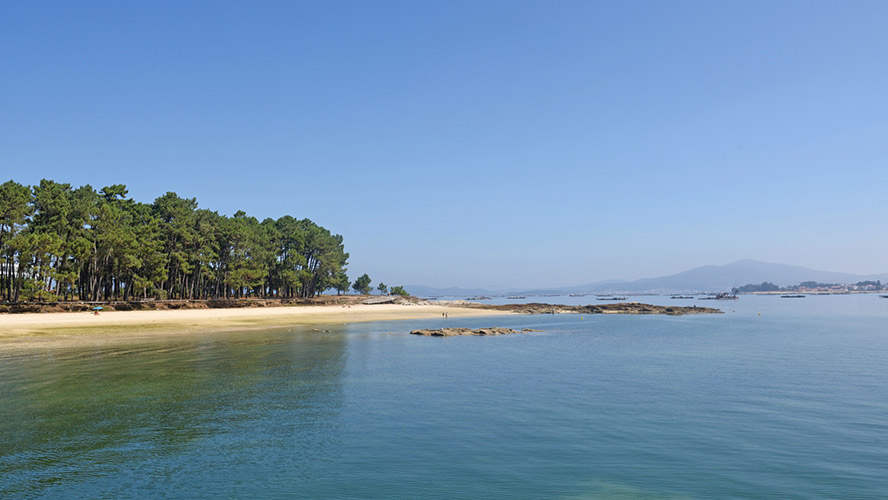
It’s worth taking a trip to the island to enjoy its fantastic viewpoints and to explore incredible Carreirón Natural Park.
Ribera Sacra
This area is famous for its wine, landscapes and history, and is a wonderful place where you can enjoy nature in all its wild glory. You’ll spot vines growing between rivers that wind into the mountains, and wine from Ribera Sacra has helped make this part of Pontevedra famous for its food and drink.
There are also man-made monuments to enjoy, such as the iron bridge by the school of Eiffel at Os Peares that spans the meeting point of the Sil and Miño rivers, and the monasteries of María de Xunqueira and Santo Estevo.
Santa María de Xunqueira is one of the most popular attractions in the area, even though only parts of the monastery, church and cloister still remain. Romanesque Santo Estevo stands by a gorge along the Sil River and has a spectacular location.
If you’d like to see Ribera Sacra from another perspective, travel to Santo Estevo and take a catamaran trip along the Sil.
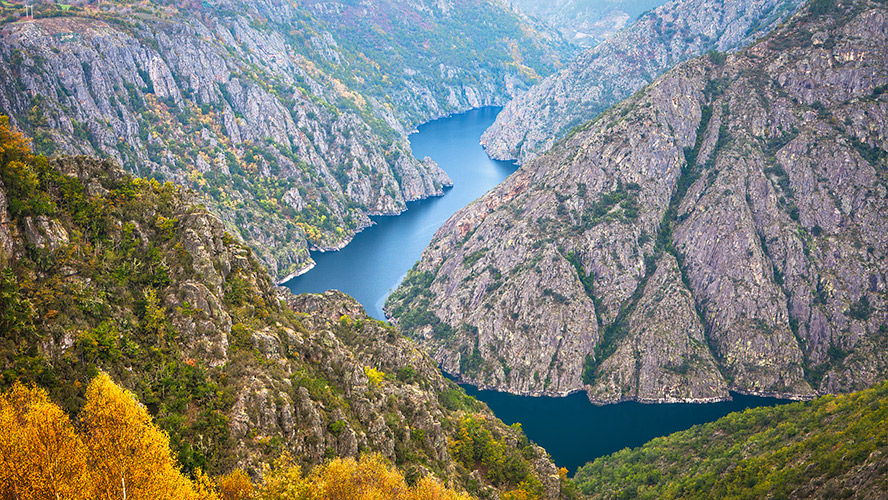
Hotels in Pontevedra province
One of the best places to stay when visiting Pontevedra is the Occidental Vigo, close to the heart of Vigo and well-connected to Urzáiz train station and the future AVE station, the airport and motorway.
The hotel is on Rúa Vía Norte, just moments from the centre and shopping district, and it has fantastic views of the Vigo estuary.
It has 104 fully equipped rooms with a wealth of unique features where you can rest and recharge your batteries.






































































